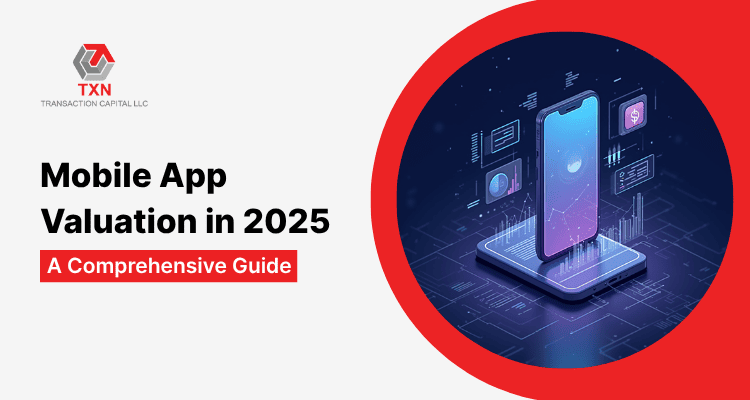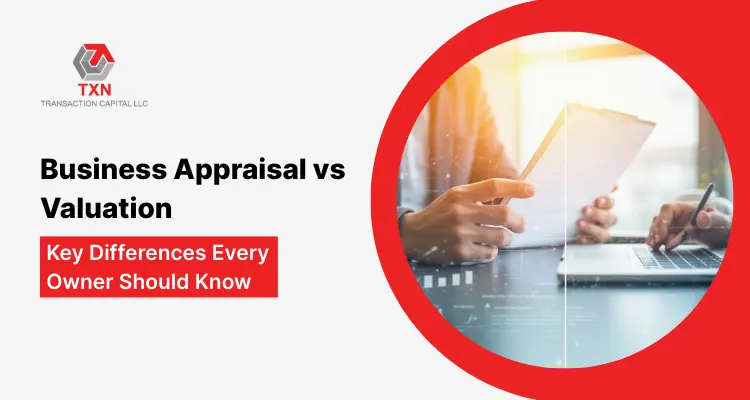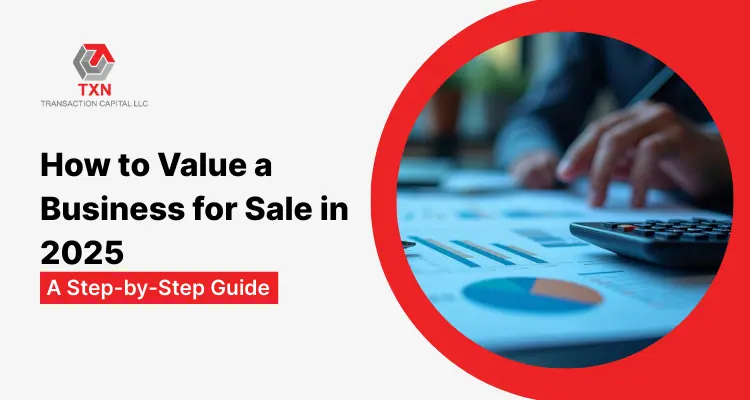Mobile App Valuation in 2025: A Comprehensive Guide

The mobile app valuation landscape has fundamentally transformed in 2025, with applications now recognized as substantial digital assets requiring professional assessment. Whether you’re preparing for investment rounds, planning an acquisition, or need compliance for tax purposes, understanding your app’s true market value is critical for strategic decision-making.
Mobile app valuation determines the economic worth of your digital application based on financial performance, user engagement, market position, and growth potential. In 2025, this process has become more sophisticated, incorporating advanced analytics and regulatory compliance standards.
At Transaction Capital LLC, our certified valuation professionals (ABV®, ASA, MRICS, CVA®) deliver audit-ready mobile app valuations that meet IRS, AICPA, and USPAP standards. Our comprehensive approach ensures your valuation withstands regulatory scrutiny while supporting your business objectives.
What Makes Mobile App Valuation Critical in 2025?
Mobile app valuation has evolved beyond simple revenue calculations to encompass comprehensive business analysis. In today’s market, accurate app value assessment influences every major business decision.
Why Professional App Valuation Matters Now
Modern mobile application pricing considerations extend far beyond basic metrics. Your app’s valuation impacts:
- Fundraising success – Investors demand professionally validated valuations
- Tax compliance – IRS requires certified appraisals for equity transfers
- M&A negotiations – Buyers expect audit-defensible valuations
- Employee equity – 409A valuations ensure compliance with stock option plans
- Strategic planning – Accurate valuations guide investment decisions
Current Market Dynamics Affecting App Worth
The mobile app market value has reached unprecedented levels in 2025. Global app revenues exceeded $270 billion, representing 15% year-over-year growth. This expansion creates both opportunities and valuation complexities.
Digital asset valuation now considers emerging factors like AI integration, blockchain capabilities, and cross-platform functionality. Apps leveraging these technologies command premium valuations due to enhanced user value and competitive positioning.
Get a Certified, Audit-Ready App Valuation Now – Book a Professional Valuation Consultation Today.
How Do You Calculate Mobile App Valuation?
Mobile app valuation methods in 2025 employ multiple approaches to ensure accuracy and defensibility. Professional valuators combine quantitative analysis with qualitative assessment for comprehensive results.
1. Revenue Multiple Valuation Method
The revenue multiple approach remains the most widely used mobile app valuation model for generating consistent income streams.
Formula: App Value = Annual Revenue × Industry Multiple
2025 Industry Multiples:
- SaaS productivity applications: 5.0x–7.0x
- Health and wellness apps: 3.5x–4.5x
- Gaming and entertainment apps: 2.0x–3.0x
- E-commerce and marketplace apps: 4.0x–6.0x
Example Calculation: An e-commerce app generating $800,000 annually with a 4.5x multiple: $800,000 × 4.5 = $3.6M valuation
2. EBITDA Multiple Valuation Model
For established apps with positive earnings, EBITDA multiples provide reliable app business valuation benchmarks.
Formula: App Value = EBITDA × EBITDA Multiple
2025 EBITDA Multiples by Category:
- Subscription SaaS: 14x–16x
- Ad-supported platforms: 8x–10x
- Marketplace apps: 12x–14x
- Utility and productivity tools: 10x–12x
This method works best for mature applications with predictable cash flows and established operating metrics.
3. Discounted Cash Flow Analysis
DCF analysis projects future earnings and discounts them to present value, making it ideal for startup app valuation scenarios.
Formula: App Value = Σ (Future Cash Flow ÷ (1 + Discount Rate)Year)
2025 Discount Rates: :
- Early-stage apps: 25%–35%
- Growth-stage apps: 20%–25%
- Mature apps: 15%–20%
DCF analysis requires detailed financial projections and careful risk assessment to ensure accuracy.
What Alternative Valuation Methods Apply to Mobile Apps?
Beyond traditional financial approaches, specialized mobile app valuation methods address unique digital asset characteristics.
1. User-Based Valuation Approach
This method values apps based on their user base and engagement metrics, particularly useful for pre-revenue applications.
Formula: App Value = Monthly Active Users × Value per User × Growth Factor
2025 Value per User Benchmarks:
- Social networking: $8–$12 per MAU
- Gaming applications: $5–$8 per MAU
- Productivity tools: $10–$15 per MAU
- E-commerce platforms: $15–$25 per MAU
2. Market Comparable Analysis
Market-based valuing a mobile application compares your app to recent transactions and public company valuations.
Process:
- Identify comparable apps by industry and size
- Analyze recent acquisition multiples
- Apply appropriate adjustments for differences
- Calculate estimated value range
3. Cost-Based Valuation Method
This approach considers development expenses, enhancements, and depreciation to determine mobile app worth.
Formula: App Value = Total Development Costs + Enhancements – Accumulated Depreciation
Cost-based valuation works best for early-stage apps or internal transfer purposes.
Which Metrics Drive Mobile App Value in 2025?
Understanding key performance indicators helps optimize your app value assessment and identify improvement opportunities.
1. Essential Financial Metrics
Revenue Metrics:
- Monthly Recurring Revenue (MRR)
- Customer Lifetime Value (CLV)
- Average Revenue per User (ARPU)
- Revenue growth rate and predictability
Cost Metrics:
- Customer Acquisition Cost (CAC)
- Operating expenses and burn rate
- Gross margin and unit economics
- CLV/CAC ratio (target: 3:1 or higher)
2. Core Metrics That Drive Mobile App Valuation
Understanding these essential metrics helps optimize your app value assessment and demonstrates performance to potential investors or acquirers.
| Metric | Importance for Valuation | Target Benchmarks |
|---|---|---|
| Monthly Active Users (MAU) | Indicates scale and market reach | Growth rate >10% monthly |
| Daily Active Users (DAU) | Shows frequency and user loyalty | 20%+ of MAU for strong apps |
| DAU/MAU Ratio | Engagement indicator | 20%+ is strong, 30%+ is excellent |
| Customer Lifetime Value (CLV) | Higher CLV = better monetization | 3x+ Customer Acquisition Cost |
| Customer Acquisition Cost (CAC) | Lower CAC = greater efficiency | <33% of CLV for sustainability |
| CLV/CAC Ratio | Profitability and growth potential | 3:1 minimum, 5:1+ ideal |
| Monthly Recurring Revenue (MRR) | Predictability of income streams | 10%+ month-over-month growth |
| Churn Rate | User retention and satisfaction | <5% monthly for consumer apps |
| App Store Rating | Market perception and quality | 4.5+ stars with 1000+ reviews |
| Session Duration | User engagement depth | Industry-specific benchmarks |
3. Critical User Engagement Indicators
Engagement Metrics:
- Daily Active Users (DAU) and Monthly Active Users (MAU)
- DAU/MAU ratio (target: 20%+ indicates strong engagement)
- Session duration and frequency
- User retention rates by cohort
Growth Metrics:
- New user acquisition rate
- Viral coefficient and organic growth
- Market penetration by geography
- Platform distribution and dependencies
4. Operational Performance Factors
Technical Metrics:
- App store ratings and reviews
- Download and uninstall rates
- Platform performance and stability
- Security and compliance standards
Market Position:
- Competitive differentiation
- Market share and positioning
- Regulatory compliance status
- Scalability and technical infrastructure
Ready for Funding or Exit? Let Us Help You Maximize Your App’s Market Value –
Contact Us Now.
How Do Industry Categories Affect App Valuation Multiples?
Mobile app valuation varies significantly across industries due to different monetization models, user behaviors, and market dynamics.
2025 Valuation Multiples by App Category
| App Category | Revenue Multiple | EBITDA Multiple | Key Value Drivers |
|---|---|---|---|
| SaaS Productivity | 5.0x–7.0x | 14x–16x | Subscription retention, enterprise adoption |
| Health & Fitness | 3.5x–4.5x | 10x–12x | User engagement, premium conversions |
| Gaming & Entertainment | 2.0x–3.0x | 8x–10x | MAU growth, monetization efficiency |
| E-commerce | 4.0x–6.0x | 12x–14x | Transaction volume, marketplace network effects |
| Financial Services | 6.0x–8.0x | 16x–20x | AUM growth, regulatory compliance |
| Education & Learning | 4.0x–5.5x | 11x–13x | Course completion rates, corporate partnerships |
Premium Valuation Factors
Apps command higher multiples when they demonstrate:
Technology Innovation:
- AI-powered personalization
- Blockchain integration capabilities
- Advanced analytics and insights
- Cross-platform synchronization
Market Position:
- Dominant market share
- Strong brand recognition
- Network effects and viral growth
- High switching costs for users
Financial Strength:
- Predictable recurring revenue
- Strong unit economics
- Efficient customer acquisition
- Diversified revenue streams
Case Study: ABC Fitness App Valuation Analysis
This real-world example demonstrates how mobile app valuation methods apply to an established fitness application seeking investment funding.
1. Company Overview and Performance Metrics
ABC Fitness App Details:
- Annual Revenue: $10 million from subscription and premium features
- User Base: 30% premium conversion rate from freemium model
- Business Model: Freemium with subscription tiers and in-app purchases
- Key Differentiator: AI-driven personalized workout recommendations
- Platform Coverage: iOS, Android, and web-based versions
- Market Position: Strong brand recognition in competitive fitness app market
2. Valuation Methodology Applied
Market-Based Approach Selected: Given ABC Fitness’s established revenue stream and comparable market transactions, the market approach provided the most reliable app business valuation.
Comparable Analysis Process:
- Identified similar fitness apps with recent transactions
- Analyzed revenue multiples from comparable sales
- Applied appropriate adjustments for ABC’s unique features
- Calculated estimated valuation range
Applied Revenue Multiple: 2.28x (based on comparable fitness app transactions)
3. Valuation Calculation and Results
Final Valuation Calculation:
- Annual Revenue: $10,000,000
- Applied Multiple: 2.28x
- Estimated App Value: $22.8 million
Investment Structure:
- Funding Sought: $5 million for expansion and marketing
- Equity Offered: 21.93% based on $22.8M valuation
- Use of Funds: User acquisition, product development, market expansion
4. Key Value Drivers Identified
Primary Valuation Factors:
- High user retention rates and engagement metrics
- Proprietary AI technology creating competitive moats
- Strong premium user conversion rates (30% of user base)
- Cross-platform availability reducing platform dependency
- Established revenue streams with growth potential
Strategic Advantages:
- AI-powered personalization technology
- Strong brand recognition in fitness market
- Diversified revenue model reducing risk
- Scalable technology infrastructure
- Clear path to international expansion
What Qualitative Factors Influence Mobile App Worth?
App business valuation extends beyond numbers to include strategic and operational considerations that impact long-term value.
1. Monetization Model Strength
Revenue Diversification: Apps with multiple income streams reduce risk and increase valuation. Strong models combine:
- Subscription-based recurring revenue
- In-app purchase opportunities
- Advertising and sponsorship income
- Partnership and affiliate revenue
- Premium feature monetization
Pricing Strategy: Freemium models with strong conversion rates demonstrate user value and willingness to pay premium prices.
2. Competitive Positioning and Moats
Sustainable Advantages:
- Proprietary technology and algorithms
- Exclusive data access and insights
- Strong brand recognition and loyalty
- Network effects and user communities
- Regulatory barriers to entry
Market Dynamics:
- Total addressable market size
- Growth rate and market maturity
- Competitive landscape intensity
- Barriers to new entrants
3. Technical Infrastructure and Scalability
Platform Architecture:
- Cloud-native design and scalability
- Multi-platform compatibility
- API integration capabilities
- Security and compliance standards
- Technical debt and maintenance requirements
4. Intellectual Property
- Patent portfolio strength
- Trademark protection
- Trade secret preservation
- Software licensing compliance
- Data ownership and rights
How Can You Maximize Your Mobile App’s Valuation?
Strategic improvements can significantly increase your mobile app market value before valuation or transaction processes.
1. Optimize Key Performance Metrics
Retention Enhancement:
- Implement personalized user experiences
- Develop gamification elements
- Create push notification strategies
- Build user community features
- Offer loyalty programs and rewards
Revenue Optimization:
- Test pricing strategies and models
- Expand premium feature offerings
- Develop corporate and enterprise versions
- Create partnership revenue opportunities
- Implement advanced analytics for insights
2. Strengthen Business Operations
Financial Management:
- Organize comprehensive financial records
- Implement robust accounting systems
- Track cohort performance metrics
- Document revenue recognition policies
- Maintain detailed cost allocation records
Legal and Compliance:
- Secure intellectual property protection
- Ensure data privacy compliance (GDPR, CCPA)
- Maintain software licensing documentation
- Verify employee and contractor agreements
- Document API and integration partnerships
3. Technical Excellence and Innovation
Platform Optimization:
- Maintain high app store ratings
- Ensure cross-platform compatibility
- Implement advanced security measures
- Optimize performance and loading speeds
- Develop API ecosystem capabilities
Innovation Pipeline:
- Integrate AI and machine learning features
- Explore blockchain and Web3 opportunities
- Develop IoT integration capabilities
- Create voice and AR/VR experiences
- Build advanced analytics and insights
Legal and Compliance Considerations for App Valuation
Mobile app valuation must account for legal and regulatory factors that significantly impact app worth and transferability.
Data Privacy and Regulatory Compliance
Essential Privacy Requirements: Modern apps must demonstrate compliance with comprehensive data protection regulations:
- GDPR (General Data Protection Regulation) – European Union requirements
- CCPA (California Consumer Privacy Act) – California state compliance
- COPPA (Children’s Online Privacy Protection Act) – Under-13 user protections
- State-level privacy laws – Expanding U.S. regulatory landscape
Apps with robust privacy frameworks and documented compliance processes command higher valuations due to reduced regulatory risk and broader market accessibility.
Intellectual Property and Licensing Documentation
Critical IP Components: Comprehensive intellectual property documentation significantly impacts digital asset valuation:
Third-Party Licensing:
- Software development kits (SDKs) and libraries
- Font, media, and graphic asset licenses
- API usage rights and restrictions
- Music, video, and content licensing agreements
Proprietary Assets:
- Source code ownership and contributor agreements
- Algorithm and methodology patents
- Trademark registrations and brand protection
- Trade secret documentation and protection
Verification Requirements:
- Full ownership documentation for all proprietary elements
- License compliance audits for third-party components
- Contributor agreement completeness
- Open-source license compatibility reviews
App Store Policy Compliance and Risk Management
Platform Policy Adherence: App store violations can severely impact valuation through:
Prohibited Practices:
- Fake review manipulation and artificial ratings
- Black-hat App Store Optimization (ASO) techniques
- Deceptive monetization or subscription practices
- Policy violations leading to app store removal
Risk Mitigation Strategies:
- Regular policy compliance audits
- Transparent user communication and pricing
- Ethical marketing and promotion practices
- Documented compliance procedures and training
Platform Dependency Assessment: Apps heavily reliant on single platforms face valuation discounts due to policy change risks and limited distribution flexibility.
What Emerging Trends Shape App Valuation in 2025?
Digital asset valuation continues evolving with technological advancement and market development.
Technology Integration Impacts
- Artificial Intelligence: Apps incorporating AI for personalization, automation, or analytics command premium valuations due to enhanced user value and competitive differentiation.
- Blockchain and Web3: Applications with cryptocurrency integration, NFT marketplaces, or decentralized features attract growing investor interest and valuation premiums.
- Extended Reality (XR): AR/VR capabilities expand addressable markets and create new monetization opportunities, particularly in gaming, education, and e-commerce sectors.
Regulatory and Privacy Considerations
- Data Privacy Standards: Apps demonstrating strong privacy compliance and user data protection receive higher valuations due to reduced regulatory risk.
- Platform Policy Changes: Apple’s App Store and Google Play policy modifications affect monetization strategies and competitive positioning.
- International Expansion: Global compliance capabilities and localization features expand total addressable markets and increase valuation multiples.
Market Evolution Factors
- Subscription Economy Growth: Recurring revenue models continue commanding premium valuations due to predictability and scalability.
- Enterprise Adoption: B2B functionality and enterprise sales capabilities significantly increase valuation multiples and growth potential.
- Sustainability Integration: ESG-focused features and carbon-neutral operations appeal to impact investors and socially conscious users.
Get Your Professional Mobile App Valuation Today
Transaction Capital LLC stands as a premier provider of mobile app valuation and digital asset appraisal services, serving startups and growth companies across 35+ industries. Our certified professionals (ABV®, ASA, MRICS, CVA®) deliver audit-ready valuations that withstand regulatory scrutiny while supporting your strategic business objectives.
Professional Affiliations:
- American Institute of CPAs (AICPA)
- American Society of Appraisers (ASA)
- National Association of Certified Valuators (NACVA)
- Royal Institution of Chartered Surveyors (RICS)
Transaction Capital LLC delivers certified mobile app valuations that meet the highest professional standards while supporting your strategic objectives.
Ready to determine your mobile app’s true market value?
Contact Transaction Capital LLC today for your professional valuation consultation.
Frequently Asked Questions About Mobile App Valuation
1. What’s the typical revenue multiple for mobile app valuation in 2025?
Mobile app valuation multiples range from 2.0x to 7.0x revenue, depending on the app category, growth rate, and monetization model. SaaS productivity apps command the highest multiples (5.0x-7.0x), while gaming apps typically see lower multiples (2.0x-3.0x) due to user acquisition costs and retention challenges.
2. How often should I update my mobile app valuation?
App value assessment should be updated every 6-12 months or following significant milestones such as major product launches, funding rounds, substantial user growth, or revenue achievements. Regulatory requirements like 409A valuations typically mandate annual updates with quarterly assessments for rapidly growing companies.
3. What user metrics most significantly impact mobile app worth?
Mobile app market value depends heavily on Daily Active Users (DAU), Monthly Active Users (MAU), and the DAU/MAU ratio. A healthy ratio exceeds 20%, while premium apps often achieve 30%+. Customer Lifetime Value (CLV) and Customer Acquisition Cost (CAC) ratios above 3:1 indicate strong unit economics and command higher valuations.
4. Can pre-revenue mobile apps receive meaningful valuations?
Yes, startup app valuation for pre-revenue applications focuses on user-based metrics, market potential, and technical capabilities. User-based valuation multiplies Monthly Active Users by per-user value ($5-$25 depending on category), while market comparable analysis benchmarks against similar-stage companies and technology capabilities.
5. What documentation do I need for professional mobile app valuation?
Professional digital asset valuation requires comprehensive financial records, user analytics, technical specifications, intellectual property documentation, and legal compliance records. Transaction Capital LLC provides detailed checklists during our free consultation to ensure efficient valuation processes and accurate results.
6. How do app store ratings impact mobile app valuation?
App store ratings significantly influence mobile app market value. Applications rated 4.5 stars or higher with substantial review volumes demonstrate user satisfaction and market acceptance. Poor ratings (below 4.0) can reduce valuations by 15-25% due to user acquisition challenges and retention concerns.
7. What discount rate should I use for DCF mobile app valuation?
Mobile app valuation DCF models typically employ discount rates between 18-30%, adjusted for specific risk factors. Early-stage apps use higher rates (25-30%), growth-stage applications use moderate rates (20-25%), while mature apps with predictable cash flows use lower rates (18-22%). Professional valuators adjust these rates based on market conditions and app-specific risks.



